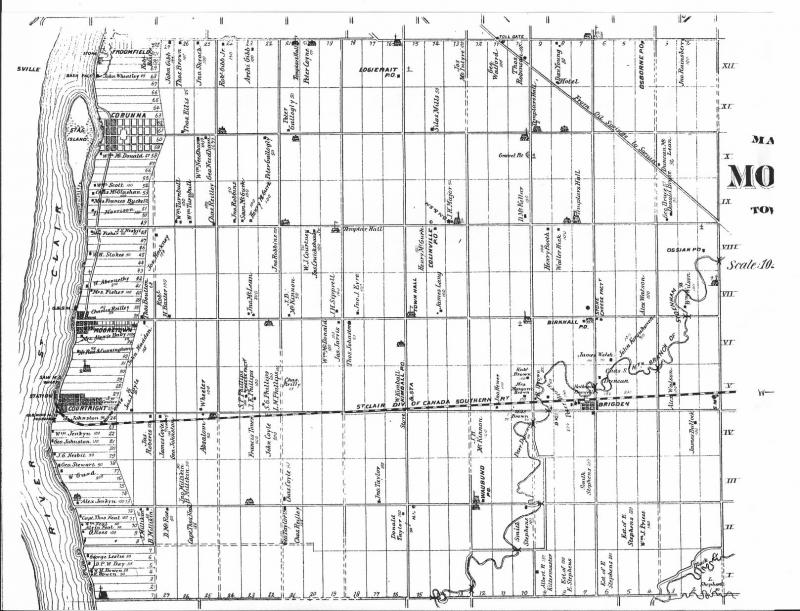
The St. Clair River flows throughout the history of the former Moore Township. The river brought the first explorers and settlers to its banks. It brought supplies to their shores and carried their products to market. It provided easier transportation than the muddy trails inland.
The St. Clair River owes its name to Father Louis Hennepin, a Roman Catholic priest aboard the Griffon as it sailed upbound for furs in 1679 under the command of explorer LaSalle. He chose the name for Lake St. Clair and the St. Clair River based on the fact that French expedition discovered them on the feast day in honour of Ste. Claire.
Even though the early explorers had travelled through the area, the land that would become Moore Township was not settled early. The first recorded English settler on the east side (Canadian side) of the St. Clair River did not arrive until about 1800. Born in England, John Courtney was involved in the fur trade at Detroit. He saw this area from the sailing vessel and felt it would be an ideal area in which to settle. Courtney’s early arrival is evidenced by his son’s tombstone which reads, “Born in Moore, 1802”. Courtney settled about 1 km north of what would become the village of Mooretown. He and his wife, Bertha Traxler Courtney, were buried between two pear trees planted by Jesuit missionaries. Much of the other early settlement of Moore Township was by French settlers, including Louis Campeau, J. Baptiste Papineau and James Bâby.
Prior to 1829, the land that would become Moore Township, Sombra Township and Walpole Island was called the District of St. Clair. The survey carried out by Roswell Mount in 1829 set apart the townships. Moore was named in honour of Sir John Moore, a British army captain who was killed in the battle of Corunna, Spain in 1809. At the time of the 1829 survey, there were 24 settlers in Moore Township.
These earliest settlers built their homes near the river. Schooners on the river provided easy transportation compared to the dense bush and muddy trails inland. This same waterway carried the settlers’ canoes and other small boats for supplies. A settler did not need to dig a well with the river’s clear, clean water at hand. Fish supplemented the settlers’ diet and ice harvested in large blocks in winter could be stored, packed in sawdust, for summer use.
The 1830’s saw the arrival of many settlers in Moore Township. To encourage settlement, the British government gave grants of land to army and navy officers and soldiers. The riverfront was settled by retired officers as well as businessmen with some wealth. These settlers could afford to hire help for the laborious task of clearing their land. This help often came from those who settled the interior areas of the township, the farmers, labourers and private soldiers. With less ready cash, and more accustomed to physical labour, these men used this rigorous work to supplement their incomes while they established their own farms.
By 1840, when municipal government was established, there were 138 taxpayers listed in Moore Township, with an additional 643 family members. Taxes were 50 cents to $1.50 per 100 acres. By this time, three-quarters of the population still lived along the river.
*********************************************
For further information, please download this file, “A Brief History of Moore Township“, written in 1934.

